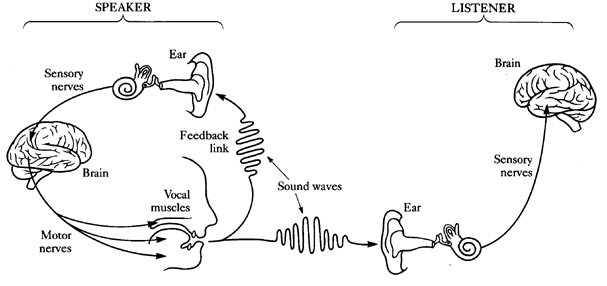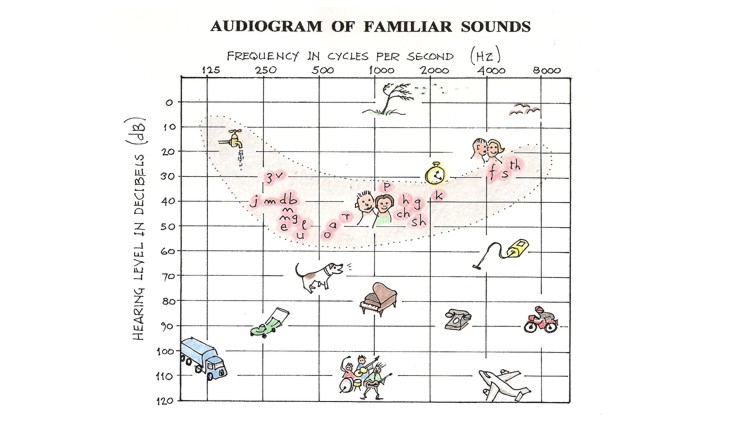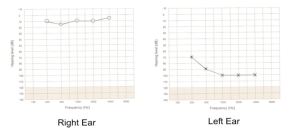Hearing problems, hearing impairment and being deaf can affect many children and adults either temporarily (e.g. fluctuating hearing loss in children) or permanently. Hearing loss in childhood can severely delay speech, language, and literacy development, and most adults will experience a deterioration in their hearing as they get older. Thankfully, hearing aid technology has moved a long way in recent years. Digital hearing aids are now much smaller, are able to pick up less background noise, and tune in more specifically to speech frequencies. Unfortunately, amplification of sound will never replace normal hearing. The development of cochlear implants however, have provided many profoundly deaf children and some adults with a hearing system that allows them to hear speech more clearly as well as develop their own speech skills. Neonatal screening programs are also leading to early detection of hearing loss and allowing parents and professionals to prepare earlier for the deaf child and put appropriate systems in place to facilitate communication and learning.
How does hearing work?
Hearing is a very complex process. When the sound reaches the ear, a complex chain of events will occur before the sound is registered and understood by an individual. Any problems that occur during this process may cause hearing impairment or deafness.
Outer Ear
Initially, the sound will travel through the air and reach the outer ear (the part you an see on the side of your head, also called the pinna). It will then travel down the auditory canal and causes the tympanic membrane (ear drum) to vibrate.
Middle Ear
The tympanic membrane vibrates and sends the vibrations along 3 tiny bones (the ossicles) in the middle ear, the malleus, incus and stapes (also called the hammer, anvil and stirrup) to the cochlea.
Inner Ear
The vibrations then reach the cochlear and this sends tiny waves through the fluid in the cochlear and displaces a layer called the basilar membrane. The displaced basilar membrane excites minute hair cells. The hair cells send electrical signals along the auditory nerve fibres to the facial nerve
Central Auditory Nervous system
The nerve fibres send the auditory information through several processes in the brain to the auditory cortex where the information is processed and we usually understand or recognise it. This whole process takes less than a second. A problem at any point from the outer ear to auditory cortex can cause a hearing impairment, or a problem with understanding information when it is being processed (auditory processing disorder).
The Speech Chain
The Speech Chain shows how important hearing is in the whole communication process, not only for the listener, but also for the speaker. When we speak we are receiving feedback of what we are saying through our ears. We are able to monitor our volume, articulation and that what we are saying is making sense. At the same time, we are processing this information and our brains are planning what we will say next, and sending these signals to our speech muscles. While this is happening, the listener is hearing our speech, processing it and (hopefully) understanding what we are saying. The inability for hearing impaired people to monitor their own speech is one reason why they may sometimes have difficulties producing clear speech.
The “Speech Banana”
The “Speech Banana”
The diagram above represents an audiogram (a graph that shows the results of hearing test) and shows the noise level and frequency of many familiar sounds. As we can see from the diagram, rock bands and jet aeroplanes are very loud, producing sounds at around the 120 decibel level, while a dripping tap and whispering is around the 10-20 decibel level. The shaded area is sometimes called the “Speech Banana”. Normally spoken speech sounds fall within the banana shaped area. Normal speech is spoken at around 30-50 decibel level, with individual sounds varying in frequency. For instance, an “m” sound is much lower in frequency than an “s” sound. This is important to be aware of, because certain forms or degrees of hearing impairment can have a greater or lesser effect on the perception of certain sounds.
Hearing Assessment
Hearing is assessed in several ways. Click here to go to our Hearing Tests and Assessment section.
Hearing impairment
Hearing impairment can occur for several reasons:
- Some babies are born deaf, usually due to genetic reasons, or some form of trauma during the pregnancy or birth
- Damage to the hearing mechanisms due to loud noise exposure, disease, trauma, or exposure ototoxic drugs can damage the hearing mechanisms
- Some form of blockage in the outer or middle ear (see Otitis Media below) will cause hearing impairment, although this may only be temporary
Once hearing impairment has occurred it may be more likely to effect high or low frequency sounds, or both, depending on the nature and extent of the impairment. Hearing impairment can effect the outer and middle ear (conductive loss) or the inner ear (sensori-neural loss).
Conductive hearing loss
Conductive hearing loss occurs when there is a problem occurring at the outer and/or middle ear, and hinders the sound from reaching the inner ear. Some conductive hearing loss is temporary and treatable. With the outer ear, anything that blocks the auditory canal (wax, foreign object, swelling from infection etc), can impede sound.
Conductive hearing loss is common among children with around 6% of children experiencing at least one episode, mainly due to otitis media (”glue ear”) of the middle ear. For some children the problem persists or recurs and this may affect speech and language development. Conductive loss can be caused by infections, a perforated eardrum, wax blockage, damage to the ear or ossicles (bones on in the middle), and disease. Oto-sclerosis is another disorder that can cause a conductive hearing loss and is caused by abnormal bone growth within the middle ear (although it is a rare disorder).
Otitis Media (Glue Ear)
Otitis media or “glue ear”is the most common cause of conductive hearing loss in children and is a general term to describe a number of conditions affecting the middle ear. Infections can cause a lot of pain, the tympanic membrane (ear drum) to rupture, and fever. The inflammation of the middle ear caused by this infection can affect the conduction of sound. Otitis media with effusion is an infection of the middle ear which also causes a collection of fluid in the middle ear space. If this fluid remains for a period it can become thick and glue like (hence the term “glue ear”), hindering the middle ear to effectively carry sound.
Otitis media can be a long term infection and can keep recurring over the early years of a child’s life. It is important to be aware that your child’s hearing could be impaired and you may not have any obvious signs. If you have concerns ask your doctor for a referral to an audiologist or Ear, Nose and Throat (ENT) Specialist, because prolonged deafness in the early years can cause a delay in speech and language development.
Grommets
Antibiotics are generally used to clear an otitis media infection, or if the infection persists a tympanostomy tube (often called a “grommet”) may be inserted to drain the fluid and equalize the pressure in the middle ear. Grommet’s can be highly effective and generally just fall out of the ear after several weeks or months. Parents have often noticed huge changes in their child’s communication and behaviour following the fitting of grommets.
Sensori-neural hearing loss
Sensori-neural loss is a result of damage to the inner ear (cochlear) and/or the auditory pathways that carry sound to the brain. There are a number of factors that are responsible for sensorineural loss including injury, exposure to loud noise, disease, certain ototoxic drugs, meningitis, tumours, stroke and genetic causes. The most common cause of sensori-neural loss is by presbycusis which may be responsible for up to 90% of hearing impairment amongst adults. Presbycusis is an age related hearing loss and describes what happens to most people as they get older. As we age the nerve cells in our cochlear die and get damaged and we see decline in our hearing ability. With children, around 50% of cases of sensori-neural loss will have a genetic cause, and loss may also be caused by birth prematurity, or infection during pregnancy. Sensori-neural loss is most likely to affect our ability to hear higher frequency sounds. Inner ear hearing problems may also include recruitment, which makes the ear more sensitive to louder sounds, so although there is a hearing loss, a sound level slightly above the level of hearing can be painful.
Tinnitus
Tinnitus can also accompany hearing impairment in later life, with a constant or intermittent sound in one, or both ears. This sound can be very distracting and unpleasant, especially when trying to get to sleep. There are a number of different devices that can help with tinnitus such as devices that produce soothing background noise to help with sleep or when trying to concentrate in a very quiet environment. Some people have also found complementary therapies such as acupuncture may help. It is always best to discuss any treatments or therapies with your doctor before embarking on them.
Mixed hearing loss
A mixed hearing loss is less common, but it is possible for an individual to have both a conductive and sensorineural hearing loss, a mixed hearing loss.
If there is a family history of hearing impairment, a diagnosed syndrome associated with hearing impairment, or you have had certain infections during pregnancy it is important to have your child’s hearing checked early. The same is true if the baby was premature or has suffered difficulties during birth. In the first 2 years of life it is important to be aware that a hearing difficulty can arise from meningitis, head trauma, certain ototoxic medications, and otitis media. Babies should display certain behaviours if their hearing is working . Young babies should:
- Respond to your voice
- React to sudden noises
- Like musical toys
- Turn towards you when you speak
- Use different sounds during babbling
Older children may display a number of other signs that they have a hearing impairment:
- They do not respond to loud sudden noises
- They do not respond when you talk or call them
- Speech and language is not developing along normal milestones
- They have difficulty following instructions, especially when they are not looking at you when you speak
- They need the TV turned up loud
- They may be withdrawn
- They may appear to mumble more frequently
Treatment for Deafness
There are a number of ways to treat deafness and hard of hearing. To read more about treatment for deafness, hearing aids and cochlear implants, click here to go to our Hearing Treatment section.
Top 10 tips to help communication with a deaf or hearing impaired child
There are many things we, and those around us, can do to make life easier when hearing impairment occurs:
- If your child has hearing difficulties and is older and able, encourage them to explain to new people that they have difficulties with hearing. This will allow others to compensate for, and understand their difficulties.
- Avoid important discussions with your child when you are in an environment with lots of environmental background noise, or background noise at home (e.g. the washing machine or the TV is on).
- Look at the child when you talk to them, often facial expressions and lip movement can give your child lots of cues to tune into certain words.
- If you are talking to a child with hearing impairment, speak clearly (but not exaggerated) and use your hands to gesture (or sign) and add cues and give meaning.
- Encourage your child to wear their hearing aid and look after it. It is a complex piece of equipment and needs care and maintenance. When your child first starts using a hearing aid, they may find it a strange sensation and it may take a while to get used to. Encourage them to persist with wearing the aid because they will get used to it and see the benefits.
- Investigate local support groups and government funding options to find out about hearing impairment support services and funding for aids, services and equipment.
- Investigate what other equipment is available to help with hearing impairment such as vibrating alarm clocks, enhanced doorbells, services to help with the telephone calls etc.
- If your child can read use the subtitles option when watching films and television. Most DVDs now come with a subtitles option.
- At school make sure the teacher is aware of your child’s difficulties and has an understanding of hearing impairment – just because your child has a hearing aid, does not mean they are hearing like other children in the classroom. Students with hearing impairment need modifications to the environment, and teachers need to change their style of teaching to accommodate students with hearing problems.
- Consider an FM system in the classroom which provides the teacher with a microphone that is linked to the student’s hearing aid. Make sure the teacher is trained in the use of this system and when to use it.
Communicating with Deaf Children
There are many strategies and programs to help deaf children. Click here to go to our Communicating with Deaf Children section.
Also go to our Hearing Impairment Resources section for downloadable fact-sheets with information and ideas to help your child. Click Here.
Recommended Reading
For a wider range of books, click here to see our Bookshop.



